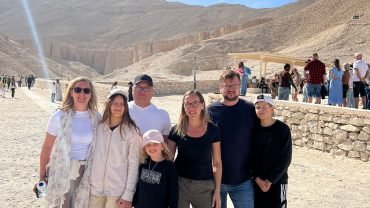The Temple of Queen Hatshepsut is a masterpiece of ancient Egyptian architecture, standing as one of the most well-preserved and awe-inspiring mortuary temples in the West Bank of Luxor. If you’re planning a trip to Luxor, this temple should undoubtedly top your list. With El Deak Tours, you can experience an extraordinary journey to explore this ancient marvel, uncovering its fascinating history, stunning design, and unparalleled cultural significance.
Why Visit the Temple of Queen Hatshepsut?
Constructed over 3,500 years ago, the Temple of Queen Hatshepsut remains a testament to the architectural brilliance of ancient Egypt. Despite the passage of time, its grandeur continues to captivate travelers from around the globe. As one of the finest examples of mortuary temples in Egypt, it offers visitors a chance to step back in time and witness the incredible legacy of Queen Hatshepsut, one of Egypt’s most powerful female pharaohs.
When you book your Luxor tour with El Deak Tours, you gain access to expert guides who bring this site to life, providing rich historical insights and uncovering the stories behind every intricate carving and statue.
The Location of the Temple of Queen Hatshepsut
The temple is located on the West Bank of Luxor, nestled at the base of towering limestone cliffs. Its setting adds a dramatic backdrop to its already impressive design, enhancing its allure and making it a must-visit attraction for anyone exploring the ancient wonders of Egypt.
One of the many advantages of booking with El Deak Tours is our expertly curated itineraries, which often include other nearby landmarks like the Valley of the Kings, the Colossi of Memnon, and other iconic sites. This ensures a comprehensive and enriching experience during your visit to Luxor.
While walking up to the temple, you’ll notice its harmonious integration with the surrounding cliffs, a feature that amplifies its beauty. Historically, the complex was known as El Deir El Bahary, or the Northern Monastery, as it was repurposed by Egyptian Copts during the early Christian era.
Historical Significance of the Temple
Although Queen Hatshepsut is credited with commissioning this temple, the site’s history predates her reign. Around 500 years earlier, Amenhotep I constructed the first temple in this area, making it a historically significant location in the West Bank of Luxor.
Excavation efforts at the temple began in the late 19th century under the guidance of Auguste Mariette, who uncovered the ruins of the Coptic monastery. Today, thanks to ongoing restoration efforts, the Temple of Hatshepsut has been returned to its former glory, offering visitors a glimpse into its original splendor.
Explore the fascinating history of this temple and other landmarks in Luxor with our expert-led tours. Check out our Luxor and Aswan tour packages for a complete Egyptian adventure.
Marvel at the Temple’s Unique Design
The layout of the Temple of Queen Hatshepsut is distinct from the traditional designs of ancient Egyptian temples, such as the Karnak Temple or Philae Temple. Instead of hypostyle halls, the temple features an impressive series of terraces and colonnades that create a sense of grandeur and symmetry.
Here are some highlights you’ll explore during your visit:
Entrance and First Terrace
Two colossal statues of Queen Hatshepsut welcome visitors to the temple. The first terrace showcases stunning inscriptions detailing the construction of obelisks that were later transported to the Karnak Temple. These inscriptions provide a fascinating glimpse into the technological achievements of ancient Egyptians.
Second Terrace
A ramp connects the first terrace to the second, which is adorned with intricate carvings depicting the Queen’s famous expedition to the Land of Punt. This historic journey, undertaken in 1459 BC, brought exotic goods like spices, incense, and plants to Egypt, underscoring the Queen’s vision and diplomatic prowess.
The second terrace also features 26 striking statues of Queen Hatshepsut depicted as the god Osiris. These statues emphasize her divine authority and reinforce her position as a powerful ruler.
Chapel of Hathor
Situated to the left of the temple entrance, the Chapel of Hathor is a must-see for art and history enthusiasts. Its columns are adorned with carvings of the goddess Hathor, and the walls feature vivid depictions of Hathor in her cow form. The intricate details and vibrant colors make this chapel a highlight of any visit.
Chapel of Anubis
On the opposite side of the temple entrance lies the Chapel of Anubis, dedicated to the god of mummification and the afterlife. This chapel is filled with captivating wall paintings showcasing offerings and depictions of various deities. It’s a fascinating stop for those interested in ancient Egyptian beliefs about life, death, and the afterlife.
With El Deak Tours, you’ll gain deeper insights into these unique features, ensuring your visit is both engaging and educational.
How to Plan Your Visit with El Deak Tours
Visiting the Temple of Queen Hatshepsut is more than just a sightseeing experience; it’s a journey through history. With El Deak Tours, you’ll enjoy personalized itineraries tailored to your interests, ensuring an unforgettable trip.
Why Choose El Deak Tours?
- Expert Guides: Our knowledgeable guides provide in-depth explanations of the temple’s history, architecture, and cultural significance.
- Customized Tours: Combine your visit to the temple with other nearby attractions like the Valley of the Kings or the Karnak Temple for a comprehensive Luxor experience.
- Hassle-Free Planning: From transportation to tickets, we handle all the details so you can focus on enjoying your trip.
Plan your visit to the Temple of Hatshepsut with us and explore our exclusive West Bank Luxor Tour packages.
Enhance Your Journey with Nearby Attractions
While the Temple of Hatshepsut is a remarkable site on its own, its location near other iconic landmarks makes it an ideal starting point for exploring Luxor’s West Bank.
Valley of the Kings
Just a short distance from the temple lies the Valley of the Kings, the final resting place of many New Kingdom pharaohs, including the famous Tutankhamun. Discover the rich history and intricate tombs of these ancient rulers with our Valley of the Kings tours.
Colossi of Memnon
Standing tall and majestic, the Colossi of Memnon are two enormous statues that once guarded the mortuary temple of Amenhotep III. These statues are a perfect photo opportunity and a fascinating stop on your Luxor adventure.
Experience Ancient Wonders with El Deak Tours
The Temple of Queen Hatshepsut is more than just a historical monument; it’s a symbol of architectural brilliance and the enduring legacy of one of Egypt’s greatest pharaohs. With El Deak Tours, you’ll enjoy an immersive journey that combines history, culture, and breathtaking sights.
Don’t miss the chance to explore this extraordinary temple and other iconic sites in Luxor.
Similar Articles
Diving Trips: Embark on These Unique Cruises with Family and Friends, Now with El Deak Tours
Enjoy an Egyptian felucca ride on the Nile with El Deak Tours
Enjoy a Cairo Aswan Luxor tour with El Deak Tours
Find out the price of the Dahabiya trip from Aswan to Luxor with El Deak Tours




Comment (0)